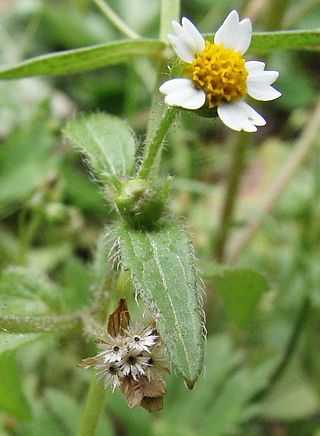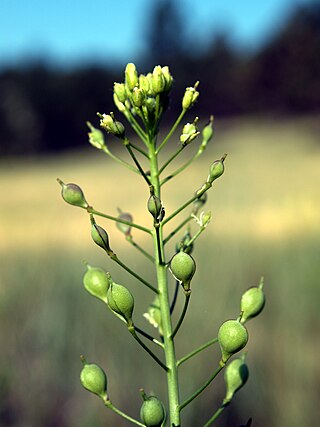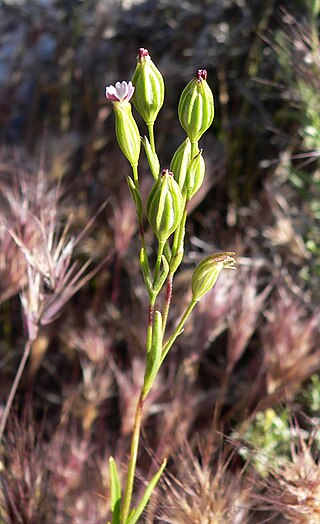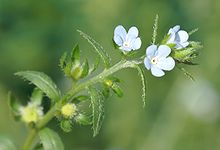
Robinia pseudoacacia, commonly known in its native territory as black locust, is a medium-sized hardwood deciduous tree, belonging to the tribe Robinieae of the legume family Fabaceae. It is native to a few small areas of the United States, but it has been widely planted and naturalized elsewhere in temperate North America, Europe, Southern Africa and Asia and is considered an invasive species in some areas, such as the temperate east coast of Australia where the cultivar 'Frisia'(Golden Robinia) was widely planted as a street tree before being classed as a weed. Another common name is false acacia, a literal translation of the specific name.

Galinsoga quadriradiata is a species of flowering plant in the family Asteraceae which is known by several common names, including shaggy soldier, Peruvian daisy, hairy galinsoga. Its native home is apparently central Mexico, although it has become naturalized in many other places.

Hackelia floribunda is a species of flowering plant in the borage family known by the common names large-flowered stickseed and manyflower stickseed.

Hackelia micrantha is a species of flowering plant in the borage family known by the common names Jessica sticktight and Jessica's stickseed.

Lappula is a genus of flowering plants in the borage family known generally as stickseeds. They are native to the northern hemisphere. These are annual herbs producing funnel-shaped flowers and prickly fruits. One of the best known species is the European stickseed, Lappula squarrosa, which is a notorious noxious weed.

Lathyrus palustris is a species of wild pea known by the common name marsh pea. It is native to Europe, Asia, and North America. It is a perennial herb with leaves made up of oval-shaped or oblong leaflets a few centimeters long. It has branched, coiled tendrils. The plant bears an inflorescence of two to eight pinkish purple pea flowers each up to two centimeters wide. The fruit is a dehiscent legume pod.

Camelina microcarpa is a species of flowering plant in the mustard family known by several common names, including littlepod false flaxlesser gold-of-pleasure and small seed false flax. It is native to Europe and Asia, and it is common across the globe as an introduced species and sometimes a noxious weed. It is known as a weed of grain crops such as wheat and rye. This is an erect annual herb producing a branched or unbranched stem 30 centimeters to one meter in height. It is sometimes coated thinly in hairs, particularly on the lower part. The leaves are lance-shaped to oblong. The upper part of the stem is occupied by an inflorescence of many pale yellow flowers. They yield plump oblong to rounded fruits, each under a centimeter long and held at the tip of a short pedicel.

Madia sativa, known by the common names coast tarweed and Chilean tarweed, is a species of flowering plant in the family Asteraceae found in parts of western North and South America.

Physalis acutifolia is a species of flowering plant in the nightshade family known by the common names sharpleaf groundcherry and Wright's ground-cherry. It is native to the southwestern United States from California to Texas, and northern Mexico, where it can be found in many types of habitat, including disturbed areas. It is sometimes a weed when it springs up in agricultural fields, but it is generally not weedy in wild habitat. This is an annual herb producing a branching stem up to a meter tall. The lance-shaped to oval leaves are up to 12 cm long and have edges lined with shallow, smooth teeth. The herbage is coated thinly in hairs appressed flat against the surface. The flowers growing from the leaf axils are round and flat-faced and sometimes over 2 cm wide. They are white to pale yellow with wide, bright yellow centers. The five stamens are each tipped with an anther about 3 mm long. The star-shaped calyx of sepals at the base of the flower enlarges as the fruit develops, becoming an inflated, ribbed lantern-shaped structure about 2 cm long which contains the berry.

Silene antirrhina is a species of flowering plant in the family Caryophyllaceae known by the common names sleepy silene and sleepy catchfly. It is native to the Americas, where it is widespread throughout North America and parts of South America. It is known in Europe as an introduced species.

Silene gallica is a species of flowering plant in the family Caryophyllaceae known by several common names, including common catchfly, small-flowered catchfly, and windmill pink. It is native to Eurasia and North Africa, but it can be found throughout much of the temperate world as a common roadside weed.
Solanum dimidiatum is a species of plant in the family Solanaceae known by the common names western horsenettle, Torrey's nightshade, and robust horsenettle. It is native to the central United States, where it grows in many types of habitat, including disturbed areas. In California it is known as an introduced species and a noxious weed. It is a rhizomatous perennial herb producing an erect stem up to 80 centimeters tall. It is covered in yellow prickles and branched hairs. The leaves may be up to 15 centimeters long, their edges wavy to lobed and sometimes toothed. The inflorescence is a branching array of several flowers. Each flower has a bell-shaped corolla measuring 3 to 5 centimeters wide. It is lavender to purple, or white. The five large, yellow anthers are about a centimeter long. The fruit is a spherical yellow berry up to 3 centimeters wide.

Solanum triflorum is a species of nightshade known by the common names cutleaf nightshade and small nightshade. It is native to Argentina, but it is known on other continents, including Europe and Australia, as an introduced species and sometimes a weed. It is present throughout much of North America, where it is possibly non-native as well. It grows in many types of habitat, including disturbed areas. It is an annual herb producing spreading, decumbent stems up one meter long. It is hairy, the hairs sometimes associated with glands. The leaves are a few centimeters long and are deeply cut into toothlike lobes. The inflorescence bears two or three flowers each just under a centimeter wide when fully open. The flower is usually white, but is occasionally purple-tinged. The fruit is a berry roughly a centimeter wide.

Torilis arvensis is a species of flowering plant in the family Apiaceae known by the common names spreading hedge parsley, tall sock-destroyer and common hedge parsley. It is native to parts of Europe and it is known elsewhere, such as North America, as an introduced species and a common weed. It grows in many types of habitat, especially disturbed areas. It is an annual herb producing a slender, branching, rough-haired stem up to a meter in maximum height. The alternately arranged leaves are each divided into several pairs of lance-shaped leaflets up to 6 centimeters long each. The leaflet is divided or deeply cut into segments or teeth. The inflorescence is a wide open compound umbel of flower clusters on long, slender rays. Each flower has five petals which are unequal in size and are white with a pinkish or reddish tinge. Each greenish or pinkish fruit is 3 to 5 millimeters long and is coated in straight or curving prickles.

Torilis nodosa is a species of flowering plant in the family Apiaceae known by the common names knotted hedgeparsley and short sock-destroyer. It is native to parts of Europe, especially the Mediterranean Basin and it is known elsewhere, such as North America, as an introduced species and a common weed. It grows in many types of habitat, particularly disturbed areas. It is an annual herb producing a hairy stem up to half a meter in maximum height. The alternately arranged leaves are each divided into several pairs of smooth-edged lance-shaped or linear leaflets. The inflorescence is a dense compound umbel of flower clusters on very short rays, often appearing like a cluster. Each flower has five petals which are unequal in size and are white with a pinkish or reddish tinge. Each greenish or pinkish fruit is about 3 millimeters long and is coated in long prickles.

Hackelia cronquistii is a species of flowering plant in the borage family known by the common name Cronquist's stickseed.

Rubus flagellaris, the northern dewberry, also known as the common dewberry, is a North American species perennial subshrub species of dewberry, in the rose family. This dewberry is distributed across much of Canada, Mexico, and the United States. It grows in diverse habitats ranging from drier savannas to temperate deciduous forests.

Lappula occidentalis, also known as flatspine stickseed, flatspine sheepburr, western stickseed, Lappula redowskii, or Redowski's stickseed, is a biennial forb native to North America and parts of Europe and Asia. It belongs to the family Boraginaceae. Variants include L. redowskii var. cupulata and L. redowskii var. redowskii, which differ in fruit morphology from the type specimen.

Hackelia deflexa is a vascular flowering plant in the borage family known by the common names, northern stickseed, nodding stickseed, and American stickseed

















